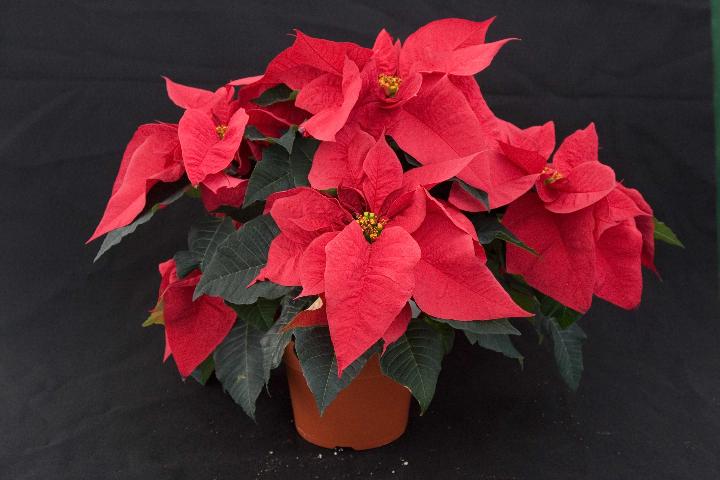
by Matt Lollar | Dec 22, 2016
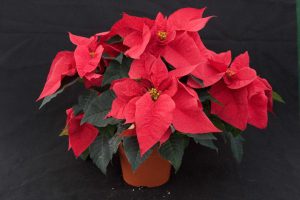
A beautiful poinsettia plant. Photo Credit: Tyler Jones, University of Florida
It’s Christmastime and time to pull your poinsettias out of the closet. Oh, you don’t have poinsettias left over from Christmas’ past? Well, if you follow some simple steps then you may be enjoying this year’s crop for years to come. But first, let’s go over a few fun poinsettia facts.
Poinsettia Facts
- The distinctive, colorful part of the poinsettia is not its flower but its petal-like leaves, botanically known as bracts. Bract color varies from red to pink, white, marble, orange, and even purple.
- The poinsettia is native to Mexico. The poinsettia got it’s name from the botanist and U.S. Ambassador to Mexico, Joel Poinsett, who introduced the plant to the U.S. in 1825.
- Contrary to popular belief, poinsettias are not poisonous to people or pets, however their milky sap can cause an allergic reaction in some individuals.
Care
With proper care, your poinsettias may stay colorful for many months. Poinsettias can retain their color until March if they are not exposed to freezing temperatures.
- Location. Poinsettias grow best in well-lit areas, but direct sun or hot lights can dry out the plants. They need at least 6 hours of indirect sunlight each day.
- Temperature. Keep your poinsettias away from drafts and chilly air. Room temperatures of 65 to 70 degrees Fahrenheit are best.
- Watering. Water your poinsettia when the surface of the soil is dry to the touch. Place a saucer under the pot, and drain the saucer if water starts to collect in it. Keep the soil from getting soggy. Too much water can kill a poinsettia.
- Humidity. Gently spray the plants with a mist sprayer or place them on gravel trays. Slightly humid air will help prolong color and life span.
- Fertilization. Lightly fertilize the plants every 4 to 6 weeks. High levels of fertilizer will reduce the quality of the plant.
- Storage/Recycling. When the leaves and bracts begin to fall off (usually in April), cut the plant back and give it sun, water, and fertilizer regularly. Starting in October, place the plant in complete darkness for 14 hours each day and in bright light the rest of the day. In December, your plant will begin to develop those beautiful, colorful bracts again.
Cut Flowers
Poinsettias may be used as cut flowers, but the stems must be treated right away. The milky sap must thicken inside the stems to prevent the plants from wilting.
Immediately after cutting, dunk the cut ends of the stems in almost boiling water for about one minute and then immediately place them in cool water. Keep the flowers away from the steam to prevent them from being damaged. Another method is singeing the cut ends of the stems with a flame for a few seconds and then placing the stems in cool water.
After the stems have been treated and placed in water, store the poinsettias in a cool place for at least eighteen to twenty-four hours before they are used in arrangements. Cut several more stems than you need, because not all flowers/bracts will survive.
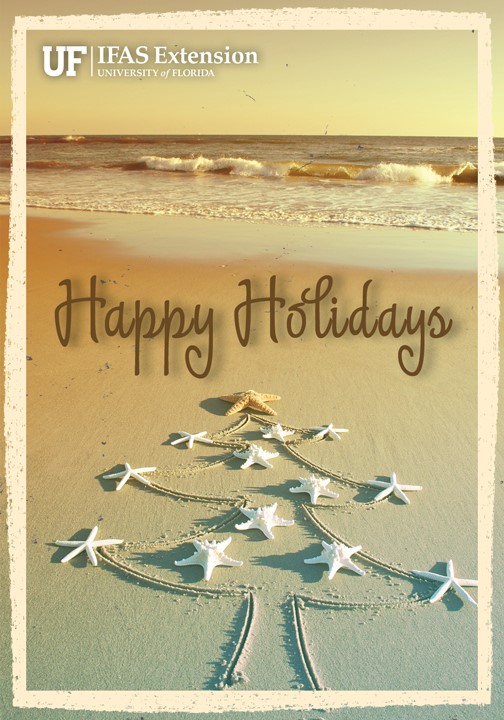
by Ray Bodrey | Dec 22, 2016
Although there are many types of artificial Christmas trees these days, live or cut trees are still very popular. Given the proper care, your natural tree can maintain its festive look throughout the holidays, keeping your safety in mind as well.
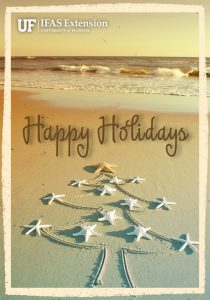
Image credit: UF/IFAS Communications.
By now many of you have already bought and displayed your trees. However, it’s not a bad idea to discuss tree selection for next year. Tree selection is important to maintain tree health and for decorating as branch sturdiness differs among varieties. White pine and red cedar are great choices for the panhandle climate, but have weak branches for hanging ornaments. Firs and spruces are better choices for this, except for our native species that require closer management.
Of course, the most important management measure to keep in mind is moisture level. A hydrated tree will reduce needle drop and keep the tree vibrant green. Don’t forget about the fire hazard a dry tree can cause. Use water holding stands and replenish often, maintaining the water level above the base of the cut tree. Clean water is the best, no additives are needed. It will surprise you how quickly and how much a cut tree will absorb. A good rule of thumb is to have a water basin that will hold approximately 1 quart of water per inch of stem diameter. The proper size stand is important. Make sure it is proportional to your tree size. A potted tree will require approximately a gallon of water a couple of times a week, depending on size. Feel the needles and check the soil for dryness, and add water when needed.
Place your tree in the coolest area of the room. Keep the tree away from air ducts, fireplaces and direct sunlight. However, a tree left in a darkened room will also promote needle drop. A space with indirect sun is best. Any heat from these factors can deteriorate the moisture level needed for a healthy tree.
This is also a popular time of year to travel. Busy with holiday plans, it’s easy to forget about caring for your tree while you are gone. If you are going to travel more than a few days, ask a friend or neighbor to water your tree, but give specific instructions. Remember, moisture is the key. The last thing to do before embarking on your holiday travel is to give your tree water. Be sure the lights are unplugged too.
Safety is the number one priority and should always be on your mind. Start by keeping any open flames or candles far away from the tree. Be careful with strands of lights and inspect before placing on the tree. If the wiring is showing age with cracks in the rubber insulation or the plug is worn, please dispose of them. Be careful not to overload circuit breakers as well. Always turn lights off before you retire for bed.
Take time to properly care for your tree. Your efforts will reward you with a beautiful, festive tree throughout the holiday season. For more information, please contact your local county extension office. Happy Holidays!
Supporting information can be found at the UF/IFAS Family & Consumer Science website: http://solutionsforyourlife.ufl.edu/hot_topics/families_and_consumers/christmas_trees.shtml
by Beth Bolles | Dec 22, 2016
A new tree or shrub is an investment for the future. When we pick an ornamental plant, we have the hope that it will survive for many years and offer seasons of beauty that enhance our landscape. Time is often spent picking a suitable spot, preparing the planting hole, and watering until establishment. We give it the best of care to make certain that our new plant becomes a more or less permanent feature.
With all of our tender love and care for new ornamentals, there is one important practice that we may neglect. Most homeowners purchase plants in containers and it is common to find root balls with circling roots. If any root ball problems are not addressed before installation, the life of your plant may be shorter than you want.
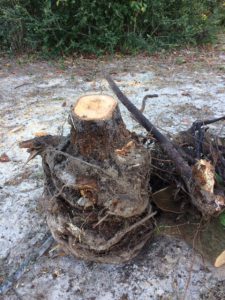
Ten years after installation, this plant was ultimately killed by girdling, circling roots. Photo by Warren Tate, Escambia County Master Gardener.
The best practice for woody ornamentals is to cut any roots that are circling the trunk or container. Homeowners may slice downward through the root ball around the entire plant. For shrubs, it is recommended to shave off “the entire outside periphery of the rootball” to eliminate circling roots. These practices allow the root system to grow outward into new soil and greatly reduce the possibility of girdling roots killing your plants years after establishment.
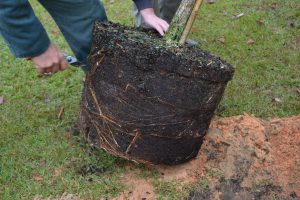
Circling roots are cut before installation. Photo by Beth Bolles, Escambia County Extension.
For more information on shrub establishment, visit the UF Publication Planting Shrubs in the Florida Landscape.
by Sheila Dunning | Dec 7, 2016
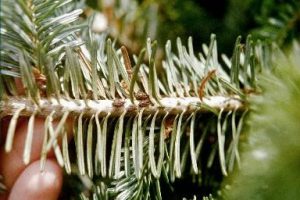 Christmas is coming. So much to do. Picking out the perfect, fresh-cut tree is one of the important
Christmas is coming. So much to do. Picking out the perfect, fresh-cut tree is one of the important 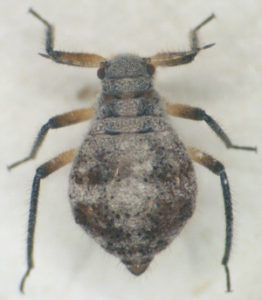 tasks. Every family member has their specific requirement. “It has to be a certain species.” It has to be a specific height and shape.” And, of course, “It has to smell great.” So, a decision is made. The perfect tree is toted home, put up and beautifully decorated. A week later, mom shrieks, “There’s ticks all over the living room!” Don’t panic. Upon inspection, you will discover that the bugs coming from your “perfect” Christmas tree are Cinara aphids.
tasks. Every family member has their specific requirement. “It has to be a certain species.” It has to be a specific height and shape.” And, of course, “It has to smell great.” So, a decision is made. The perfect tree is toted home, put up and beautifully decorated. A week later, mom shrieks, “There’s ticks all over the living room!” Don’t panic. Upon inspection, you will discover that the bugs coming from your “perfect” Christmas tree are Cinara aphids.
Cinara are a group of several species of large brown or black aphids that feed on conifers including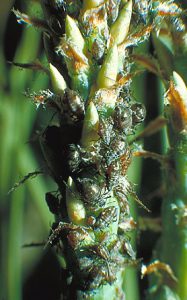 all pines, spruces and firs. When the Christmas trees are cut at the farm and bundled for shipment, the aphids get trapped. With warmer temperatures indoors, the aphids become active. Infestations may also arise from overwintering eggs that hatch. As the tree dries out, the aphids crawl from the tree into the rest of the house.
all pines, spruces and firs. When the Christmas trees are cut at the farm and bundled for shipment, the aphids get trapped. With warmer temperatures indoors, the aphids become active. Infestations may also arise from overwintering eggs that hatch. As the tree dries out, the aphids crawl from the tree into the rest of the house.
No worries. Cinara aphids only feed on conifers, so they pose no threat to other plants. They are not a danger to people or pets either. But don’t get rid of them by smashing them. You may be left with a nasty purple stain to have to clean up. Instead, pull out the vacuum and suck them up.
So, if you are one of those people still shopping for the “perfect” tree, add a preemptive strike to your decorating procedure. Unbundle and shake, shake, shake that tree outside before bringing it in. Then the only shrieking going on will be when mom opens the fabulous present you gave her.
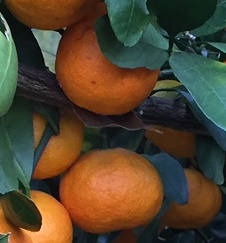
by Matthew Orwat | Dec 7, 2016
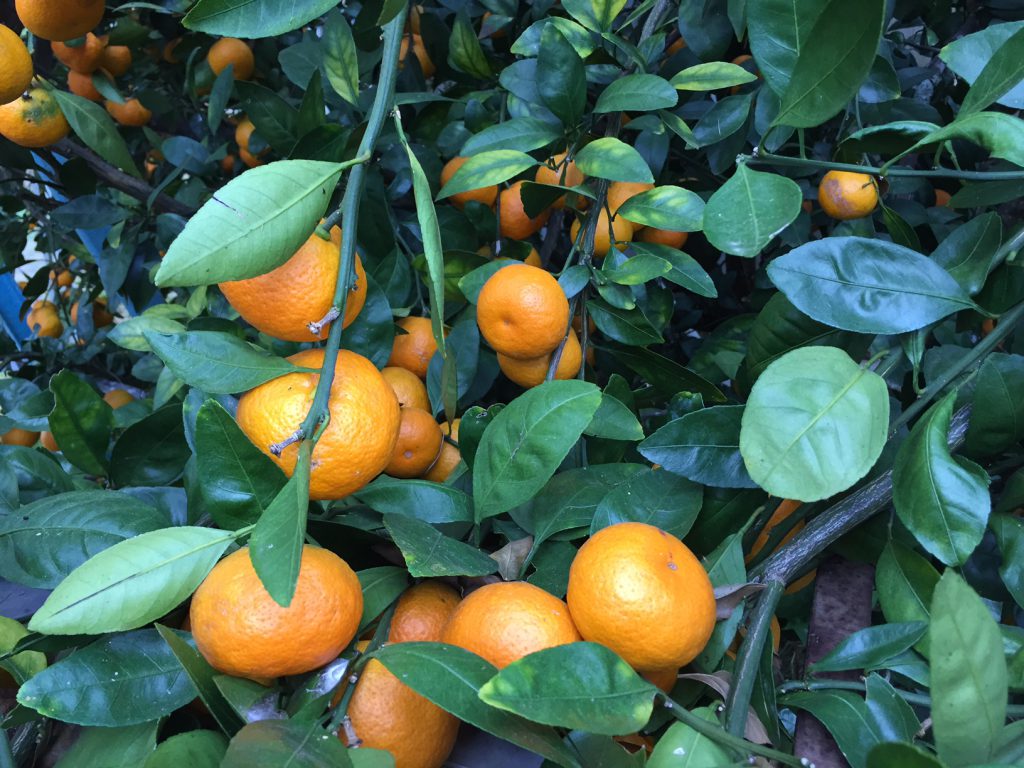
Fall 2016 Satsumas. Image Credit: Matthew Orwat
One question that repeatedly pops up in my Extension work is “When do I harvest fruit or vegetable X ?” This fall, the question of “when should I harvest my citrus?” has been a choice topic! The most common citrus in the Florida panhandle is the satsuma, Citrus unshiu, so it makes sense to limit this article to that species.
Harvesting satsumas can be a confusing activity for new citrus enthusiasts. Fall seasons in the panhandle tend to be extremely variable, from cold and wet to warm and dry or any combination thereof. To complicate matters, citrus is often grown in a protected microclimate in the garden. Thus, another variable is added to the decision tree.
Some harvest considerations to take note of:
- Sometimes the fruit is ready to harvest even when some green remains on the fruit
- Not all fruit on a given tree will be ready at the same time
- It’s a good idea to harvest a few fruit per tree and taste test….this will be a good indicator of the readiness of the other fruit on the tree
- A general trend to consider is that the longer the fruit remains on the tree, the sweeter it will become

Image Credit Matthew Orwat
When satsuma ripen, they become slightly soft. That’s a good indicator that they are ready to harvest. This softness makes them extremely easy to peel but poses a challenge when harvesting. If they are simply pulled off of the tree, some peel will be left on the tree and the fruit will be compromised. Such a fruit would have to be consumed quickly. To solve this problem satsuma are clipped off the tree, leaving a tiny bit of stem attached to the fruit. This allows the fruit to be stored and transported.
When a hard freeze is approaching (5 hours below 28ºF), it is important to harvest the fruit before this event whether or not they are ripe. Hard freezes will ruin the texture of the fruit and cause them to begin the rotting process.
Since a hard freeze is forecast for Friday December 9th 2016 for part of the Florida Panhandle, consult your local weather forecast and make your decisions accordingly. For an in-depth discussion on citrus fruit harvesting and cold tolerances, please consult this publication from Texas A& M University. Additional articles are available on cold protection and frost readiness here.











